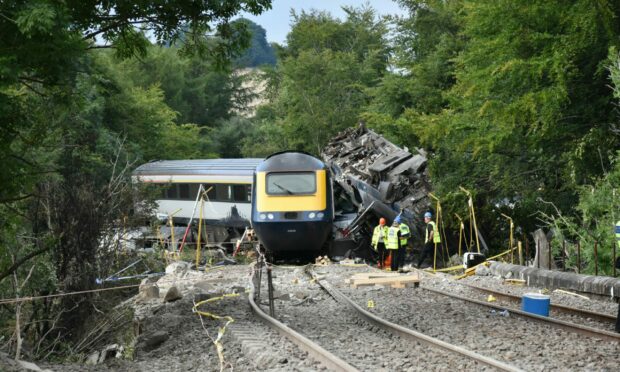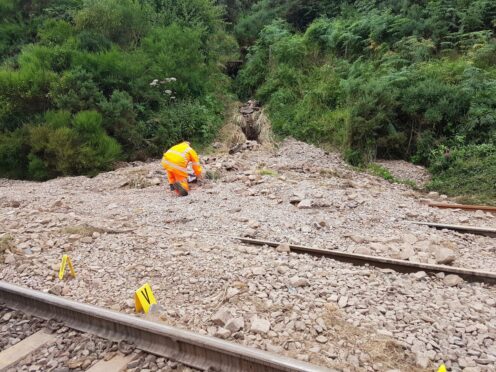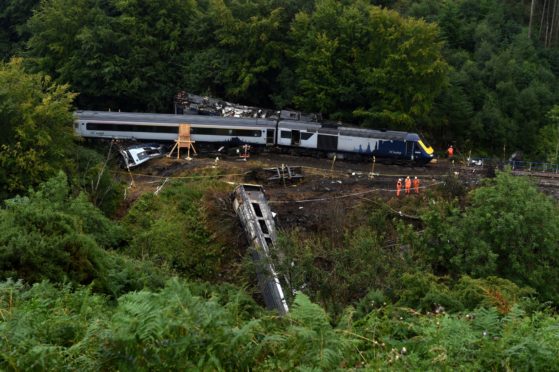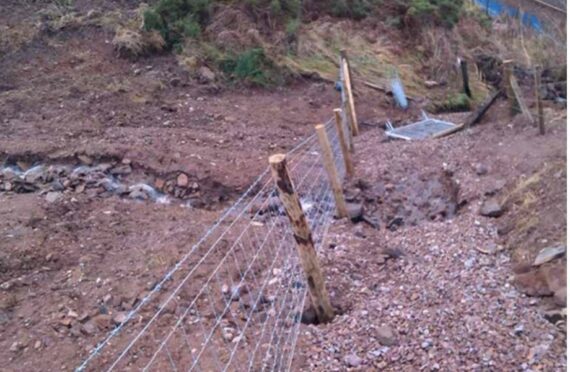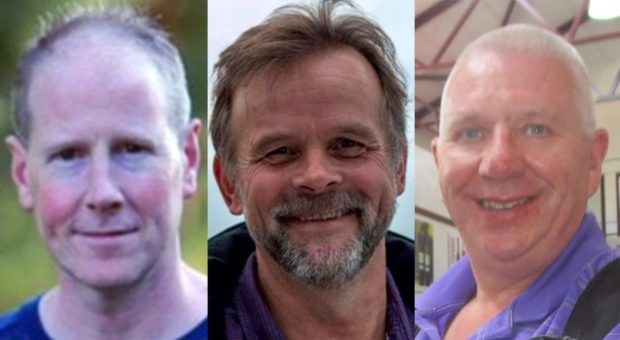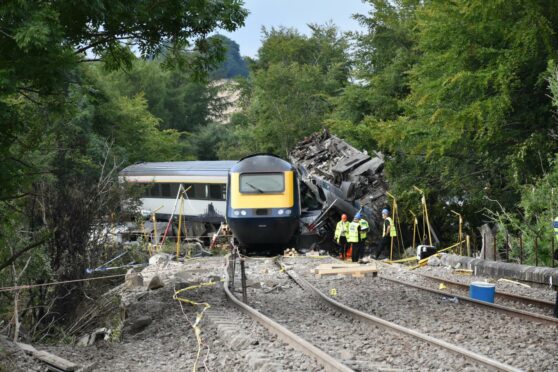The new Rail Accident Investigation Branch sheds light on what went wrong before the crash which led to the deaths of Brett McCullough, Donald Dinnie and Christopher Stuchbury.
We have analysed the 296-page report and have found seven key failings before the tragedy.
So what are the failures and what do they mean?
Failing 1 – A drain at the crash site was not built to design so couldn’t handle heavy rain
Network Rail commissioned Carillion to build the drain in a particular way in 2012.
But Carillion built it differently.
This meant too much water was diverted to the same point, which increased the chance of gravel inside the drain washing out.
Had Carillion stuck to the right design, the gravel may not have washed out onto the rail line.
Carillion went bust in 2018 so there is nobody from the firm to explain this failing.
A Network Rail spokesman said: “All our contractors are independently assessed to check they are competent to carry out the projects they are awarded.
“The drainage system for Carmont was designed to cope with the rainfall experienced on August 12.
“Carillion did not inform us that the system was not installed to the specified design.”
Failing 2 – Network Rail was unaware the drain was built to a different design
If an organisation asks a firm to do some work, you might expect it to check the work was done properly.
But that did not happen.
Had Network Rail inspected the site with the intention of discovering if it was built as requested, it could have discovered a problem and corrected it.
A Network Rail spokesman said: “We have already begun the process of putting in place additional internal assurance measures around the completion of this type of work to address the issues identified in the report.”
Carillion should have told Arup, the firm that designed the drain, it had changed the design.
Neil Davidson, a partner at Digby Brown Solicitors, which is representing some of the victims, told us: “A construction expert has said this drain should have been constructed in a certain manner by Carillion, and it wasn’t.
“The most glaringly obvious thing that struck me was that that point was not put back to the designer.”
Failing 3 – Network Rail did not put the drain in its database so didn’t inspect or maintain part of it
When any significant change is made to the railway or its immediate surroundings, Network Rail should record it on a database.
This would allow staff to monitor when it has been inspected or when it might be vulnerable to weather.
However, no record was ever made in the database, meaning Network Rail staff did not know such a change existed.
Network Rail did inspect the site twice in 2020 – months before the crash – but only checked part of it.
Had they carried out a full inspection they might have spotted a problem.
A Network Rail spokesman said it would address issues identified in the report.
Failing 4 – A landowner told Network Rail and Carillion about surface water at the site – but nobody followed up
It took only a few months for problems to arise at the site of the drain.
In December 2012, a neighbour noticed flooding there.
The RAIB report said: “The landowner stated that he passed this photograph to Carillion or Network Rail.”
However, it then adds: “No evidence has been found relating to receipt of the image or action being taken in response to it.”
RAIB described this as a “missed opportunity”.
If the neighbour did contact Carillion or Network Rail, action could have been taken to sort out the drain.
However, a Network Rail spokesman said: “We have no record of images being shared or concerns from a neighbour.”
He added: “Since the accident we have taken steps to strengthen our relationships with landowners and farmers across Scotland and have taken a proactive approach, including with key bodies such as Scottish Land & Estates and the National Farmers Union, both of whom have strong landowner membership.
“We have also increased the use of our helicopter to identify significant changes in lineside property which may have an impact on the running of our railway, so we can engage early with landowners in areas where we have concerns.
“We also use the helicopter, if it is safe to do so, when we are faced with extreme weather to check key affected locations on the network.”
Failing 5 – Network Rail installed a weather program – but didn’t properly configure or properly train staff how to use it
Network Rail brought in its Network Rail Weather Service (NRWS) in 2015 after RAIB queried why there had been six landslips on the railway in just eight months.
RAIB recommended Network Rail do something about it and Network Rail hoped NRWS would be a solution.
But it didn’t set NRWS up properly, meaning staff couldn’t get the most from it.
Network Rail did not teach its staff how to work NRWS either.
Mr Davidson said: “Network Rail has taken the decision to obtain a fancy weather monitoring system and have not trained their staff how to use it. To me, that’s negligence.
“They have got the tool, they have got the staff, but didn’t ensure their staff could interpret the data and make decisions.”
RAIB is so concerned about this it has recommended Network Rail and train operators review how their route control rooms run.
The report said: “The review should therefore examine how Network Rail ensures that route control staff are provided with appropriate training.”
Network Rail did not comment on this point.
Failing 6 – The team that routed trains was under severe pressure on the day of the crash but had no extra staff
Network Rail and ScotRail operate a route control centre in Glasgow.
Weather in north-east Scotland was severe on the day of the crash and the day before and many trains were cancelled, delayed or re-routed as a result.
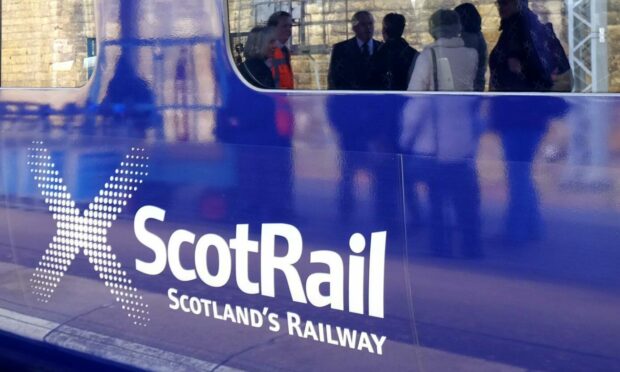
This challenging and constantly-changing situation meant Scottish control room staff were up against it.
But, because the storm had been forecast, Network Rail and ScotRail could have predicted this would happen.
However, it did not draft in extra workers to bolster numbers and relieve the pressure.
RAIB’s report described staff as being “under severe workload pressure”.
That might lead some to question what the point is of having a plan to bring in more staff if you don’t actually do so.
Mr Davidson said: “From reading the report, it sounded like chaos in the route control room.
“The people on the day should not have been allowed to make the mistakes they made because, if the systems are robust enough, it doesn’t happen.”
“Network Rail was negligent because it had experienced crashes before which led to recommendations for change which were not implemented.”
Network Rail did not comment on this point.
ScotRail chief operating officer Ian McConnell said: “The majority of the RAIB recommendations relate to other parties but ScotRail will play its part fully in ensuring that safety lessons are learned.
“We are working closely with Network Rail and the wider industry to do everything possible to reduce the risk of something like this ever happening again.”
Failing 7 – Route control staff did not restrict the speed of the train that crashed despite being aware of the four obstructions within 11 miles
The train was static at Carmont for two hours. During that time, the weather cleared and it became brighter.
It is possible Scottish route control staff thought this meant all hazards had been cleared.
However, we now know they were aware of two flooding incidents and two landslips within 11 miles of the crash scene – but still did not err on the side of caution.
Unless route control staff give an instruction for the train to go at a reduced speed, drivers must go at ‘line speed’ – whatever the recommended speed is for that section of track.
In this case, the line speed is 75mph, so the driver did nothing wrong by proceeding at 73mph.
Neither the signaller or the Network Rail employee who had been called to the scene to change the points so the train could go back to Aberdeen did anything wrong either.
Mr Davidson said: “One of the trains that was also stuck at one of the landslips in the area was routed back to Laurencekirk – it was given a reduce speed.
‘Why didn’t they recommend it reduce speed?’
“Whereas the train that derailed wasn’t and there the question would be.
“With the training they have been given, the drivers put their trust in those in the control room. They get the instruction and act upon it.
“It is a big question – why didn’t they recommend it reduce speed? However, what we are absolutely certain of is – there is no fault of the driver.”
Network Rail did not comment on this point.
‘We are already doing more’
In conclusion, the Network Rail spokesman said: “Tragic accidents are thankfully incredibly rare and our railway is one of the safest in Europe.
“The whole rail industry has worked hard to identify where improvements can be made and we’ve invested heavily in learning lessons from previous events.
“There is clearly more to do and we can, and are, already doing more.
“It’s important the changes we make in light of this report sustain improvements in safety and are implemented in a timescale that makes changes stick.
“We need time to fully understand the just-published document and do not yet know the full extent of work required for responding to each recommendation.”
ScotRail chief operating officer Ian McConnell said: “This report is a terrible reminder of the awful events of August 12 2020.
“Nobody in ScotRail or the wider industry will ever forget what happened.”
‘It makes for very sober reading’
Mr McConnell continued: “Our thoughts and prayers remain with the families, friends, and colleagues of Brett, Donald, and Christopher.
“The publication of today’s report will be another painful reminder of their loss.
“While there is nothing we can ever say to ease that pain, we have been in contact with the families and continue to offer any support we can.
“This report makes for very sober reading.
“The way the industry responds to extreme weather incidents has already changed following the events of 12 August 2020 and a number of the report’s recommendations have already been implemented.”
